The iPad Air Review
by Anand Lal Shimpi on October 29, 2013 9:00 PM ESTGPU Performance
Since the iPad Air uses the same A7 silicon as the iPhone 5s, it also uses the same on-die GPU as the 5s: IMG’s PowerVR G6430. This is a 4-cluster configuration of IMG’s latest graphics hardware, running at some relatively high frequency. I already went into some detail on the G6430 in our 5s review so I won’t rehash that here, but we’re basically looking at a shift to a more efficient scalar architecture.
I still don’t have confirmations of clock speeds, but I believe we’re looking at a max GPU clock of around 450MHz. As you’ll see from the results below, there’s a small difference in performance between the iPad Air and iPhone 5s in terms of peak GPU performance - implying very similar clocks. The difference is the iPad Air should be able to sustain its max frequency longer than the iPhone 5s can.
| Mobile SoC GPU Comparison | ||||||||||||
| PowerVR SGX 554MP4 | PowerVR G6430 | PowerVR G6430 | ||||||||||
| Used In | iPad 4 | iPhone 5s | iPad Air | |||||||||
| SIMD Name | USSE2 | USC | USC | |||||||||
| # of SIMDs | 32 | 4 | 4 | |||||||||
| MADs per SIMD | 4 | 32 | 32 | |||||||||
| Total MADs | 128 | 128 | 128 | |||||||||
| GFLOPS @ 300MHz | 76.8 GFLOPS | 76.8 GFLOPS | 76.8 GFLOPS | |||||||||
| GFLOPS as Shipping | 68.1 GFLOPS (?) | 115.2 GFLOPS | 115.2 GFLOPS | |||||||||
Since we’re talking about an A7 here and not an X-series SoC, there’s still only a 64-bit wide memory interface. As memory bandwidth is a key enabler of GPU performance I was curious to see how GPU performance compared to the outgoing iPad 4 with its much wider memory interface. Do keep in mind that the A7 does include a large system cache on-die, which can help improve effective memory bandwidth.
GFXBench 2.7
We'll start our GPU performance analysis with a look at low level results using GFXBench/GLBenchmark 2.7. The low level tests, particularly the offscreen ones, should give us some idea as to whether or not there's any increase in GPU frequency for the iPad Air vs. iPhone 5s implementations of A7.
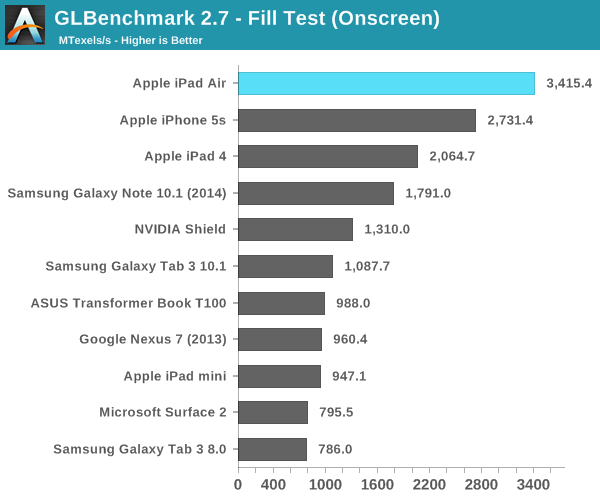
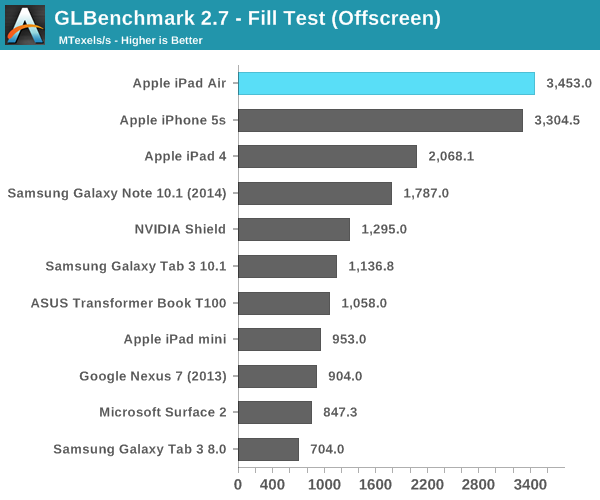
Looking at the fill rate results, there's a 4.5% increase in performance compared to the iPhone 5s. That could be the magnitude of clock increase that we're seeing between A7s. Apple could very well be relying on more thermal headroom in the iPad Air to provide any real world GPU performance advantages over the iPhone 5s.
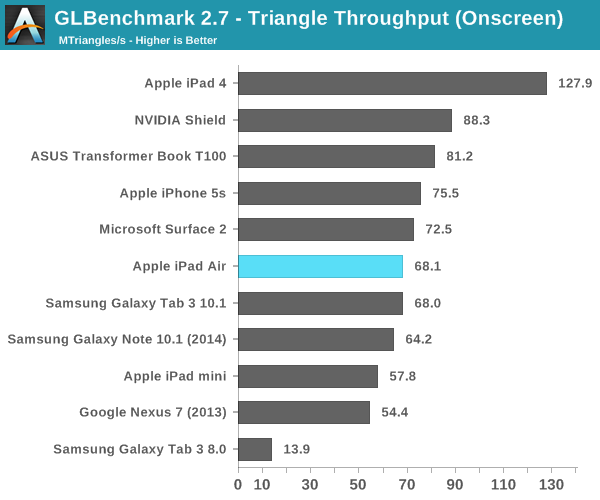

We see an even smaller gap between the Air and 5s in the triangle throughput tests (2.9%). There doesn't seem to be any substantial difference in GPU frequency between A7 implementations here. The regression in triangle rate performance compared to the iPad 4 is explained by differences in how Series 6 and Series 5XT GPUs scale in width. Whereas 5XT replicated nearly the entire GPU for "multi-core" versions, multi-cluster versions of Rogue only replicate at the shader array. The result? We don't see the same sort of peak triangle setup scaling we did back on multi-core 5XT parts. I'm not sure I'm particularly happy with the magnitude of the regression here, but I haven't seen any real world cases where it matters yet.
Next up are the game simulation tests. We'll start with the more strenuous of the two: T-Rex HD.
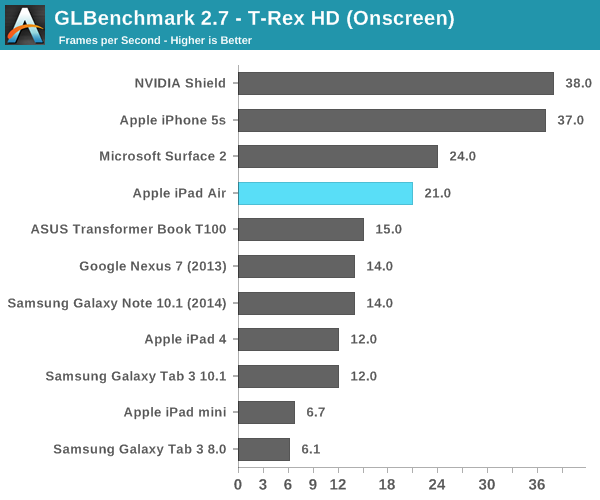
Here we get closer to Apple's claims of a 2x increase in performance. The iPad Air delivers 75% more performance than the iPad 4 in this test. Once again the iPhone 5s pulls ahead but that's because the onscreen tests render at display resolution, which is lower on the 5s.
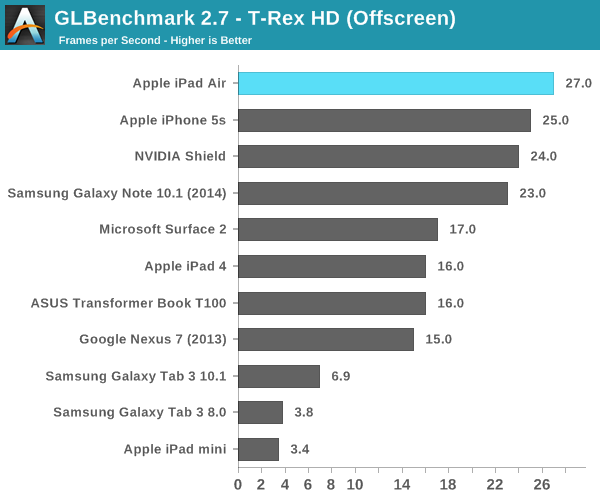
Offscreen performance sees similar scaling: ~69% better performance compared to the iPad 4.
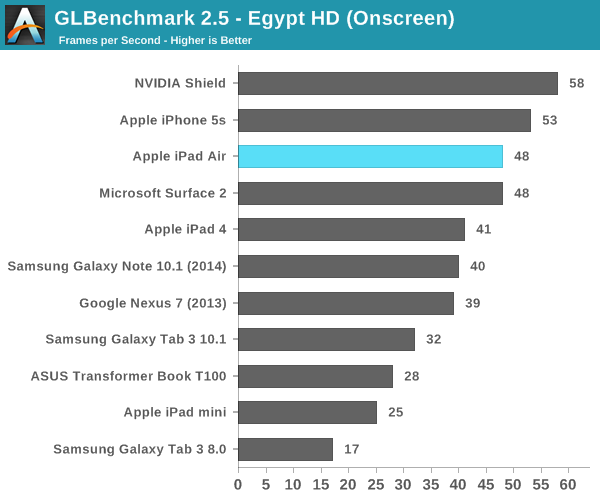
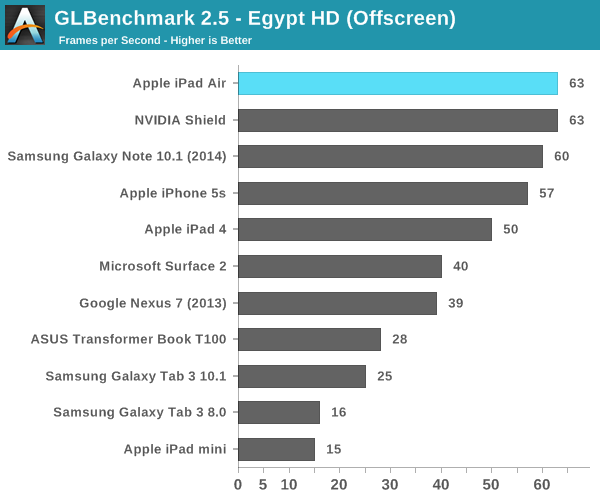
3DMark
We're once again running 3DMark's newest Unlimited mode which does its best to run independently of v-sync and at a standard resolution across all devices. I've also included 3DMark Extreme results below that feature a few more comparison points.
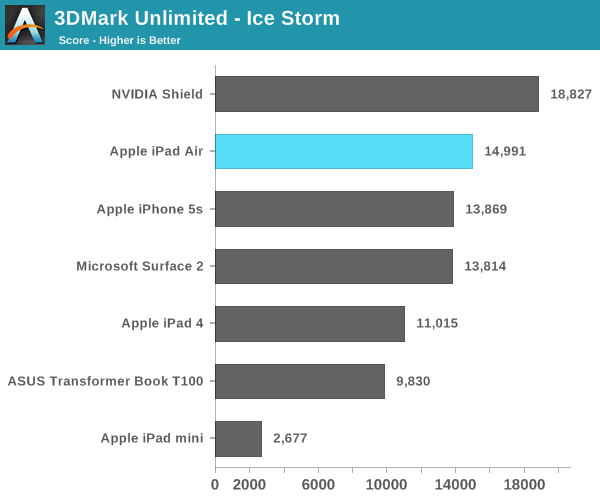
The overall Ice Storm scores show a 36% improvement in performance over the iPad 4 and an 8% increase compared to the iPhone 5s. Given the CPU frequency advantage of the A7 in the Air vs. the iPhone 5s, I'm guessing that's why we're seeing the performance gap we are here.
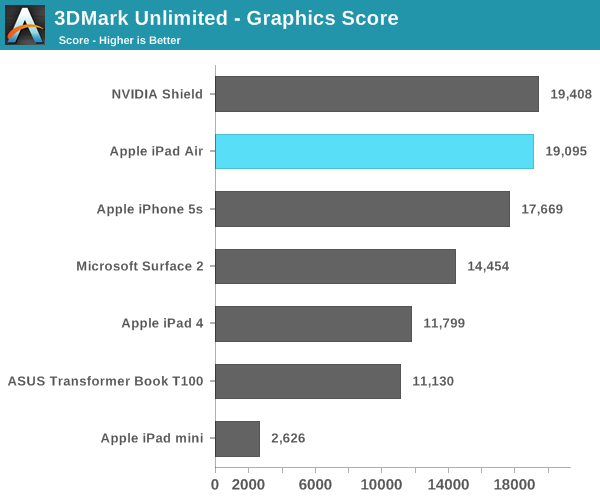
If we focus exclusively on the GPU tests (which themselves are still CPU bound), the iPad Air's performance advantage over the iPad 4 grows to over 60%.
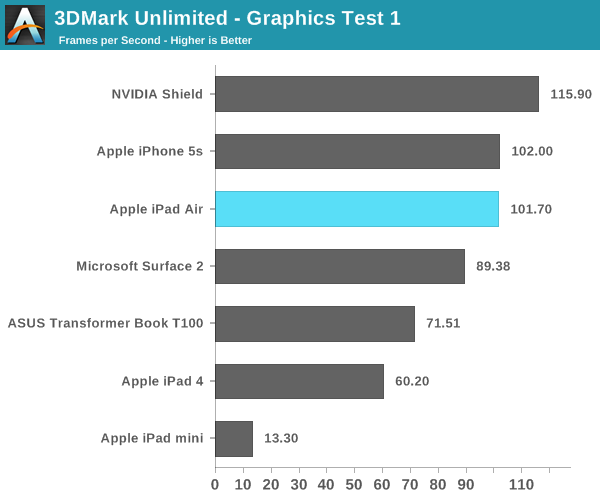
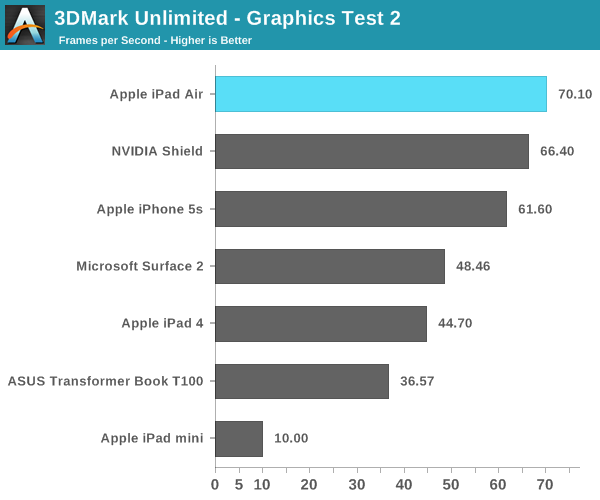
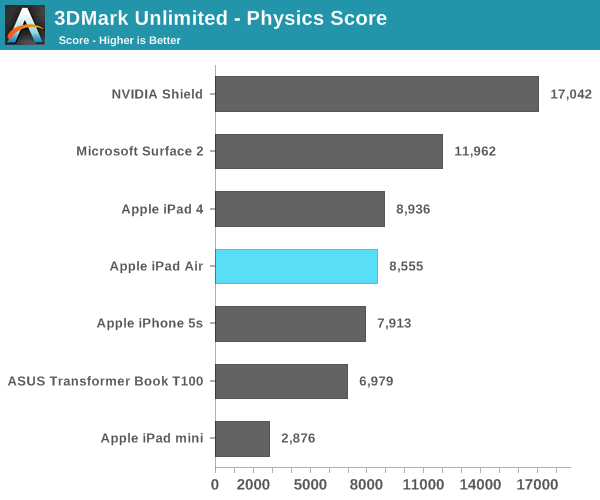
I'm still not entirely sure what's going on with the 3DMark Physics test, but we've seen this two reviews in a row now where Cyclone showed no performance increase at all compared to Swift despite this being largely a CPU test.
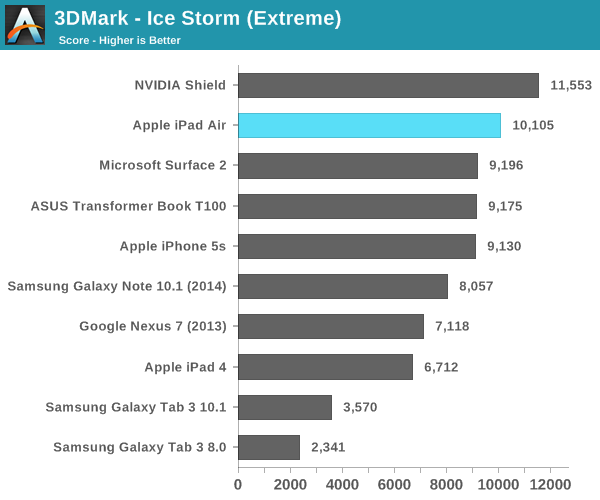
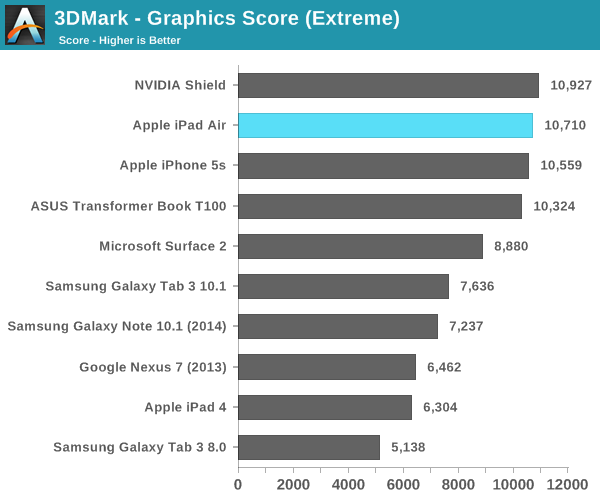
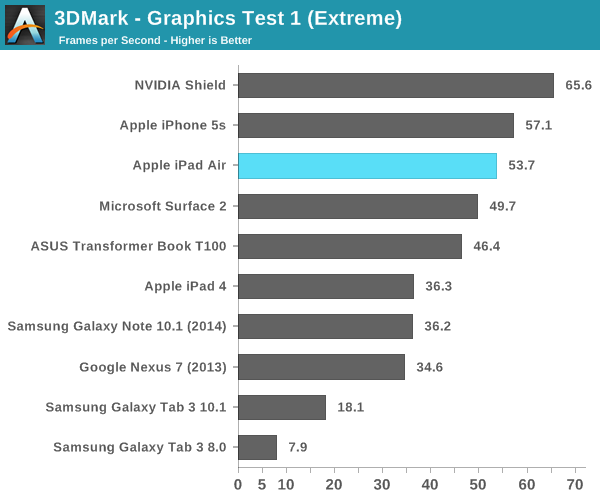
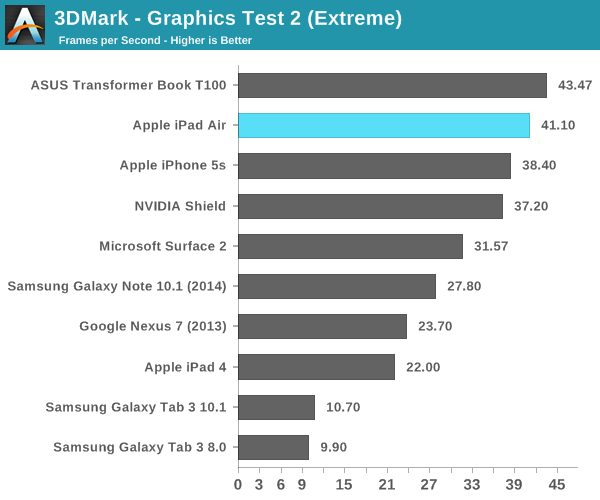

Basemark X
Basemark X is a new addition to our mobile GPU benchmark suite. There are no low level tests here, just some game simulation tests run at both onscreen (device resolution) and offscreen (1080p, no vsync) settings. The scene complexity is far closer to GLBenchmark 2.7 than the new 3DMark Ice Storm benchmark, so frame rates are pretty low.
I'm still having random issues with Basemark X reliably running both on and offscreen tests on iOS 7. Unfortunately I could only get onscreen results for the iPad Air, which came in at 46% faster than the iPad 4. Note the iPad mini and iPhone 5s benefit from having lower native resolutions here, which is why they perform so well.
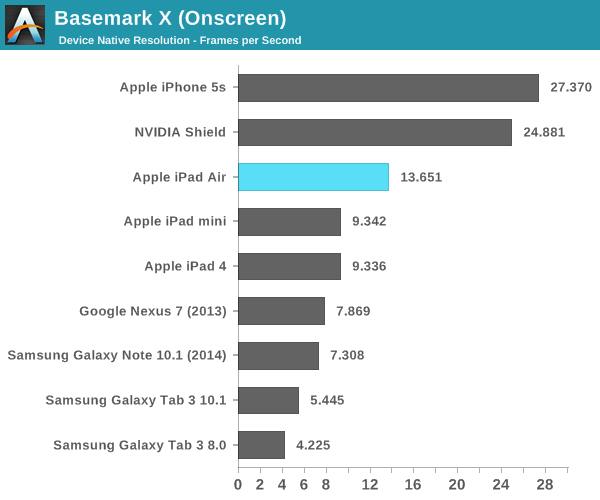










444 Comments
View All Comments
ancientarcher - Wednesday, October 30, 2013 - link
Great review Anand!Looking at the comments it seems that you just can't satisfy everyone. Well done though. Good job!
Having said that, let me now put forward my complaints. Why do you only have javascript benchmarks for the CPU?? I understand there is no ideal CPU benchmark, but what harm will it do to include a few. Nothing is perfect, but if you watch out for the usual tricks that the OEMs/chip suppliers play, you should be able to capture most if not all. Would love to see Geekbench at least in the benchmark set, for both the processor and single core results.
errorr - Wednesday, October 30, 2013 - link
Um, what cross platform benchmark exists? I don't really see any valid possibilities out there right now and nobody is more vocal about it than Anand seems to be.Spunjji - Wednesday, October 30, 2013 - link
"An interesting side effect of Apple’s pricing structure is that the cost for NAND upgrades actually gets pretty reasonable at the higher capacities."That actually made me laugh. I guess that's one way to look at it. From my perspective it's still a rip-off no matter which way you shake it...
VengenceIsMineX - Wednesday, October 30, 2013 - link
Seriously. While it is interesting, this is the one point where I think Anand's affection for Apple products has seriously affected his judgement. He would be just hammering ANY other manufacturer for charging $100 for 16 gb of NAND at today's prices but he not only gives them a pass on that, he bends over backward to point out that 64 GB to 128 GB is "only" another $100. Come on Anand, you are better than that.Spunjji - Tuesday, November 5, 2013 - link
Precisely! Thank you. I can understand the "it's their pricing structure" argument for why they charge that much (people still buy it, so why not) but there's no need to try to make it sound generous when it quite clearly is not.VengenceIsMineX - Wednesday, October 30, 2013 - link
Interesting iteration of hardware, particularly the SOC and a very solid technical review but I think in all fairness Anand, you didn't address the elephant in the room which is Apple's adherence to the $499 full size ipad price point, shameless storage & LTE gouging & what sort of value this offers. With the evolution of great smaller 7" tablets on the Android side and Windows 8.1 Bay Trail devices like the ASUS T100 coming in at prices of less than $230 and $349 respectively, you have to address what sort of value this thing offers for people who will consider it from a value perspective. Sure the Apple faithful will buy it but should those who aren't invested in Apple's ecosystem consider what is a very, very steep price in today's market? You address this in other reviews, why not here?(you do mention the storage pricing but honestly, I think at this point given NAND prices, you would be calling ANY other manufacturer to account for charging $100 for an additional 16 GB of storage, instead you bend over backward to point out how affordable the jump from 64 to 128 is. Really??? That's your take on this????)
darkcrayon - Wednesday, October 30, 2013 - link
I think your assertion about "Apple faithful" is a bit outdated. At the numbers the iPad sells, it's hard to say only a small subset of "special" people who only like Apple are buying them. Obviously a lot of people think the iPad is still worth $500, and you're not going to see a price drop until that changes. I do agree a comparison with inexpensive Windows based tablets is in order though.friendlystanger - Wednesday, October 30, 2013 - link
I am new user of this site and I am nost sure what 2 wide system means. Can anyone clarify this ?errorr - Wednesday, October 30, 2013 - link
It has to do with how many instructions van be processed by a single core on each cycle. It is a major bottleneck but comes with a huge power penalty to go wider usually.Just adding extra cores is only one way to increase parallelism.
friendlystanger - Wednesday, October 30, 2013 - link
Where can I learn more about these things? Any book,tutorial ? BTW thank you very much for your reply.